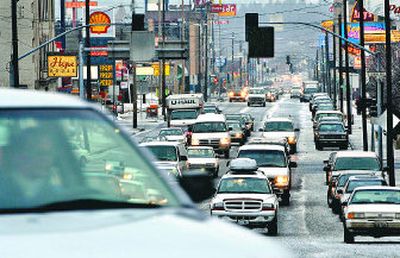Red-light cameras wait for green light

Driving along Division Street could be safer, and more expensive for some, if the city proceeds with plans to install red-light cameras at intersections to catch traffic violators.
Spokane is compiling bids from companies that offer the “Photo Red” technology, which takes photos and videos of people when they run a red light. Members of the city’s public safety committee agreed last month that putting cameras at dangerous intersections would benefit the city and the motoring public, but the rest of the City Council has yet to weigh in on the program. Police said it would not only help with public safety but more than pay for itself. Officials said it would only take about two paid violations per day to make enough money to pay for the system. Public safety officials hope to target as many high-collision intersections as possible.
A third of Spokane’s 33 most dangerous intersections are along Division, the city’s main north-south route, according to a Spokane Police Department annual report. Third Avenue at Division Street topped the list, with 27 crashes in 2006. No one was killed in last year’s crashes at any of the worst intersections, but three collisions resulted in injuries.
If Spokane mimics the results of other cities where red-light cameras have been installed, collisions will drop, authorities say. In some U.S. cities where the cameras are in use, collisions have dropped as much as 44 percent, said Spokane police Sgt. Eric Olsen, project leader of Photo Red.
An ordinance authorizing the technology still needs to be written and a contract approved by City Council members before any cameras could be installed. Bids are being accepted by the city until Feb. 12.
Once a vendor has been selected, the Police Department will give the company a list of the 33 worst intersections in the city to evaluate.
“They actually go and count how many people run the red lights,” Olsen said. “And they come back and tell us which ones would be the best for catching violators.”
Olsen speculated that cameras would be located at three or four intersections to start. The city would post notices at each camera-equipped intersection.
The city pays no initial costs for the Photo Red equipment. Many vendors guarantee that the number of violations caught by the cameras will provide the money to pay for the equipment.
“Red-light violators are a major threat to the motoring public,” said Spokane police Lt. Bill Drollinger. “I see this as a real deterrent to people running red lights.”
Collisions caused by people running red lights increased by 10.9 percent last year, Olsen said. Police estimated injuries from red-light running went up more than 22 percent.
Police say catching red-light runners is difficult, and the violation is hard to prove after the fact.
With the Photo Red program, “you will actually be able to watch yourself run the red light on the Internet,” Drollinger said. The cameras shoot still and video images.
Information about how to find those images on the Web will be provided on the $101 citation, which will be sent within 14 days of the infraction, Olsen said. The money from the citations will be used to pay for the program’s equipment and personnel.
According to a Washington statute passed in 2005, photos are restricted to rear license plates – no face pictures are allowed – photos must be available at trial, and infractions are prohibited from being included on driving records.
If the registered car owner was not driving the vehicle when the photo violation was taken, they can go to court and fight the ticket by swearing under oath or in writing they were not in control of the car at the time, according to the state statute.
“I think it’s a great program,” said Spokane Police Chief Anne Kirkpatrick. “I’m an advocate.”
City Councilman Bob Apple is less enthusiastic, and he said e-mails that he and other council members have received are skeptical of Photo Red.
Apple was in Olympia recently where legislators were discussing problems with the state statute encountered by other cities, such as vehicle owners denying they were driving when the photo was taken.
“I don’t want Spokane to be a test case legally for Photo Red,” said Apple, adding that those issues should be worked out in other cities that can better afford litigation.